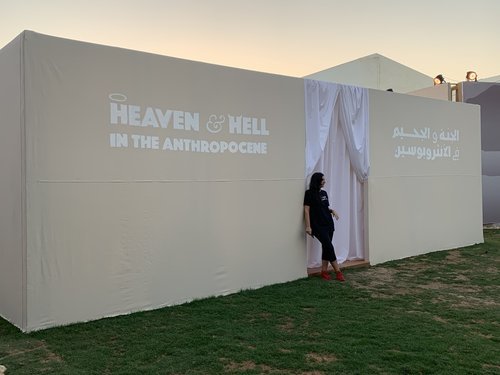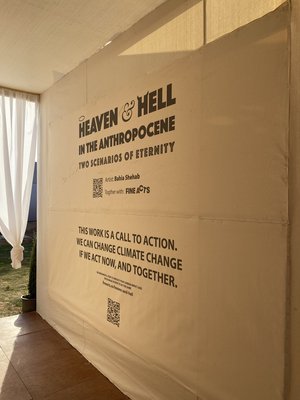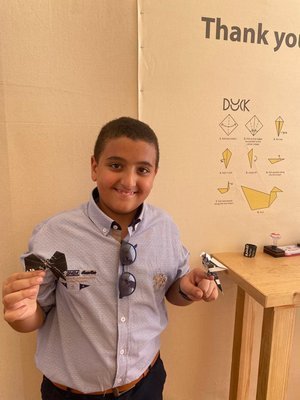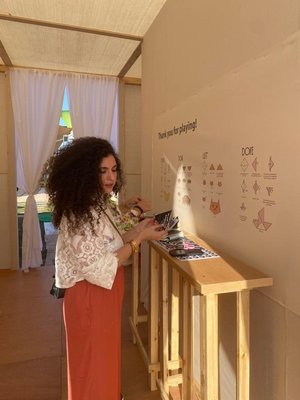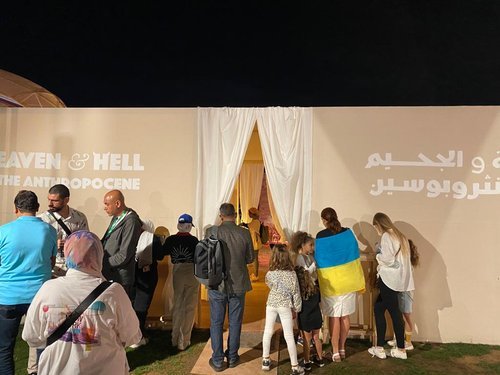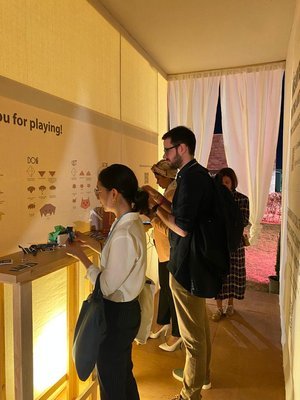How can we make world leaders truly care about climate change? To answer this question, we at Fine Acts teamed up with prominent Egyptian-Lebanese contemporary artist Bahia Shehab to create Heaven and Hell in the Anthropocene – an experiential artwork that just launched at COP27 – the 2022 United Nations Climate Change Conference happening in Sharm El-Sheikh, Egypt.
The artwork is informed by a famous study which concluded that people’s beliefs about climate change are closely tied to the temperature they’ve recently experienced – in other words, people sitting in warmer rooms are more likely to say that ‘global warming’ is a problem.
We turned this insight into an impactful artistic experience to raise questions around responsibility, participation and action. Since we couldn’t crank up the heat in COP27’s plenary rooms, we created an immersive public art installation at COP27 and invited decision-makers to experience two competing scenarios for the future.
The installation is composed of two adjacent rooms: one representing heaven and the other – hell. Participants do not know which of the two 'scenarios of eternity' they will be engaging with, since the rooms look entirely identical from the outside.
Before entering, visitors play a game, and, based on their sustainability choices, they are guided to enter either Heaven or Hell. There, all their senses are targeted by very different sights, sounds, temperatures, and smells.
Hell is a small, dark, angled, claustrophobic space. It smells of sh*t, decomposing fruit and hospital rooms. It sounds like construction, drilling, and disaster. It is set to 38°C degrees – the Arctic’s highest recorded temperature to date, as well as the body temperature over which a person is generally considered ill/unwell.
“Many governments, companies and individuals are still insensitive to scientific facts and numbers – today there are entities who do not believe in the impact we have inflicted, and are still inflicting, on the environment. Thus, a more physical and visceral experience is needed.”
Heaven on the other hand is a light, bright, gentle, domed interior. It is set at a comfortable temperature of 21°C degrees. You are surrounded by nature sounds – birds, water, wind through leaves – and scents of freshness and orange blossoms.
“For many the perception of eternity is divided between the two poles of heaven in hell. Living in the Anthropocene – this unofficial unit of geologic time, used to describe the most recent period in Earth's history when human activity started to have a significant impact on the planet's climate and ecosystems – we need to ask ourselves, what’s our eternity really going to look like? Are we going to heaven, or are we going to hell? Our multi-sensory experience highlights a future with each individual’s decisions in mind,” says artist Bahia Shehab.
The aim of the installation is to make people feel like stakeholders in our collective future and drive action towards making change possible. According to the artist, “We are at the point of Earth’s story where we as the main protagonist need to make a crucial decision. By our collective effort we can turn this planet into heaven or hell.”
The artwork is displayed on site in the Green Zone at COP27 (November 6-18). It will then be made replicable under an open license – with its key characteristics and aesthetics published online in a DIY manual, so that movements and collectives around the world can recreate it in their cities. Stay tuned for the manual!

